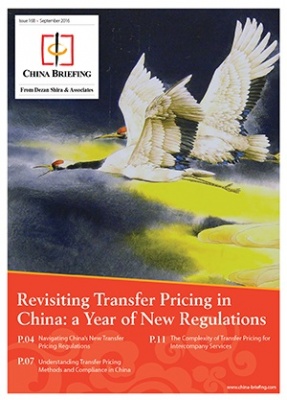
Revisiting Transfer Pricing in China: a Year of New Regulations
Published: September 20162016 has seen the release of new laws that have revamped transfer pricing compliance for MNCs in China. If implemented early in a Chinese entity’s business life, a transfer pricing system can complement and support an MNC’s business model and commercial objectives, as well as optimize its global effective tax rate. Non-compliance with China’s new transfer pricing laws, however, can result in heavy penalties for an MNC, and subsequently eat into its bottom line. In this issue of China Briefing, we provide a guide to navigating China’s latest regulations, highlighting the main issues that exist for foreign companies, and explaining the various transfer pricing methods and processes that exist.
No. of Pages: 12 pages
In this issue:
- Navigating China's New Transfer Pricing Regulations
- Understanding Transfer Pricing Methods and Compliance in China
- The Complexity of Transfer Pricing for Intercompany Services
Transfer pricing has fast become one of the standout issues in international taxation. Put simply, the practice concerns the price charged for intercompany transactions between entities in different tax jurisdictions. These transactions can be used to shift funds within a multinational company (MNC), making transfer pricing an effective means to manage a firm’s finances and remit its profits.
As more international companies began to pour into China following its opening up period in the late 1970s, the need for a transfer pricing regime that could effectively collect tax on intercompany transactions and prevent tax base erosion became increasingly apparent. Legislation on transfer pricing in the Middle Kingdom therefore has a relatively long history that stretches back to the early 1990s, but the majority of this has been piecemeal, and it is only in the last ten years that the country began implementing comprehensive regulations. 2016, in particular, has seen the release of new laws that have revamped transfer pricing compliance for MNCs in China.
If implemented early in a Chinese entity’s business life, a transfer pricing system can complement and support an MNC’s business model and commercial objectives, as well as optimize its global effective tax rate. Non-compliance with China’s new transfer pricing laws, however, can result in heavy penalties for an MNC, and subsequently eat into its bottom line.
In our 24 years of experience dealing with China’s idiosyncratic tax system, Dezan Shira has closely observed and analyzed the development of the country’s transfer pricing laws. In this issue of China Briefing, we provide a guide to navigating China’s latest regulations, highlighting the main issues that exist for foreign companies, and explaining the various transfer pricing methods and processes that exist.

